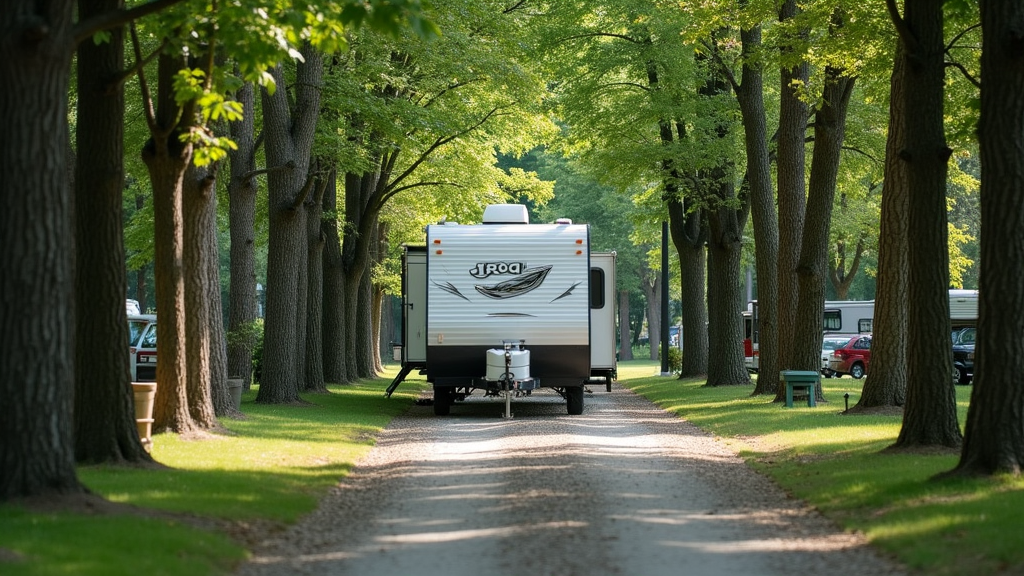Learning how to back in your RV trailer isn’t something most folks pick up right away. It’s a handy skill to have if you want that perfect camping spot or need to squeeze into a smaller driveway. The size and pivot point of a trailer add a whole new level of challenge the first time you try it. After a few trial-and-error moments myself (and one or two embarrassing situations at busy campgrounds), I’ve picked up several tips that make the process much smoother, and way less stressful.

Why Learning to Back in Your RV Trailer Matters
Backing up an RV trailer comes in handy way more often than I once thought. Whether I’m parking in a tight campground or maneuvering into place for maintenance at home, backing up is practically unavoidable. If you’re new to towing, it feels intimidating at first because turning the steering wheel makes the trailer respond in the opposite direction. Add in some onlookers and you’ve got a recipe for second-guessing yourself.
Knowing how to confidently back in your trailer isn’t just about looking smooth in front of your campsite neighbors. It helps you avoid damage to your RV, keeps your tow vehicle and surroundings safe, and saves time. Plus, it lets you fit into spots that others might pass up. Some numbers from RV industry groups have shown that low-speed accidents in campgrounds are common, mostly from awkward parking turns and missed signals. Building good backing-up habits can really cut your risks.
Understanding Your Rig: Components That Affect Maneuvering
Each RV trailer setup has its quirks. Before even touching the steering wheel, I always take a moment to think about how the length, hitch type, and mirrors will affect my backing process. Here are a few points worth considering:
- Trailer Length: Longer trailers react more slowly but might swing wider on turns. Shorter ones react quickly, sometimes too quickly if you’re not expecting it.
- Type of Hitch: A bumper pull trailer tracks differently from a fifth wheel. Fifth wheels tend to pivot closer to the cab, so each style calls for a slightly different backing approach.
- Mirror Setup: Wideangle mirrors on your vehicle help you keep track of both trailer sides and can cut down on blind spots. Upgrading or adjusting mirrors before towing is a good call.
- Pivot Point: Knowing where your pivot point is (generally right at the trailer wheels) helps you get a feel for your turning radius.
Being familiar with these pieces can give you a better mental map of how your specific trailer is going to move while backing. That’s super important for making tight turns safely.
Step-by-Step Tips to Back in Your RV Trailer
When I was first learning, breaking the process down into simple steps helped a ton. Here’s a basic game plan I still follow today:
- Scout the Parking Spot: Get out of your vehicle and walk around the area. Look for low branches, uneven ground, picnic tables, or anything that might be in the way.
- Pick Reference Points: Find a tree, rock, or site marker as a visual guide. This makes it easier to judge distance and direction.
- Align Your Trailer: Pull forward so your vehicle and trailer form a straight line. This gives you the biggest starting window and makes initial corrections easier.
- Decide on a Backing Side: Whenever possible, back in from the driver’s side. Visibility is always better from this angle than the passenger (blind) side.
- Go Slow and Steady: Move slowly and use small corrections. Large steering movements can quickly result in overcorrection.
- Use Your Mirrors: Watch both sides to see how the trailer is moving. I check my side mirrors constantly, as even small changes can have a big effect a few feet back.
- Steering Technique: Turn your steering wheel in the opposite direction you want the trailer to go. For example, to move the trailer left, you’ll turn the wheel right, and vice versa. This counterintuitive move gets easier with practice.
- Adjust as Needed: Don’t be afraid to pull forward and reset your approach if things get too tricky.
The biggest help for me was to go slow and avoid rushing. I also found that using walkietalkies or my phone on speaker with a spotter gave me a huge boost in confidence when I couldn’t see everything myself.
Common Mistakes and How to Avoid Them
Even with practice, backing in a trailer throws curveballs. Here are some things I’ve stumbled on and tips to avoid them:
- Oversteering: It’s easy to overcorrect by turning the wheel too much. This can cause the trailer to jackknife or swing too wide. Use gentle, gradual corrections whenever possible.
- Ignoring Surroundings: I learned the hard way that parking spots aren’t always as clear as they seem. Doublechecking for posts, rocks, or tree limbs before moving is simple but really important.
- Not Using a Spotter: Even with good mirrors, blind spots are real. Having someone guide you with simple hand signals or calls over a radio can prevent a lot of headaches.
- Panicking Under Pressure: An audience or busy campground can turn up the anxiety. Focusing on the process rather than the people around helps keep nerves in check.
- Skipping Out on Practice: The more I practiced in empty parking lots, the easier it became. Practicing in lowstress environments pays off when it counts.
Oversteering
Even experienced RV drivers oversteer from time to time. I’ve found that starting with my hands at the bottom of the steering wheel helps make the connection between my hand movement and how the trailer moves. Small adjustments go a long way. If things start to go sideways, I just stop and pull forward a little to straighten out before trying again.
Ignoring Surroundings
A quick walkaround before starting gives your brain a mini map of the area. I always check for things like dropoffs or tree stumps that could catch my bumper or trailer. Bringing a flashlight if you’re arriving after dark can make a big difference, too.
Not Using a Spotter
Even if you feel pretty confident, a spotter can keep an eye on the blind side and warn you before you get too close to hazards. Picking someone you trust and agreeing on basic signals (like stop/go/left/right) keeps things simple. I never rely solely on bystanders who shout directions since mixed signals are just confusing.
Panicking Under Pressure
If the campground is crowded and folks are watching, I take a deep breath and focus on my process. Going slow and steady makes a better impression than trying to impress with speed, and making a mistake.
Extra Tips for Tricky Backing Situations
There are times when backing is extra challenging, like when the spot is on a hill, space is limited, or visibility is bad. I’ve tried a few different tricks that make tough situations a little easier:
- Use Marker Cones: Putting small cones or objects at the edge of your parking space helps you figure out where your trailer needs to go. This lowtech method is pretty handy.
- WalkieTalkies or Apps: Using clear communication with a spotter makes everything smoother. Handsfree phone calls or special apps like “RV Whisperer” can help if you don’t have walkietalkies.
- Practice at Home: Setting up lines or cones in a wide open parking lot or driveway at home allows you to work out the kinks without stress.
- Backing Cameras: An aftermarket wireless camera on the back of your trailer helps a lot with visibility, especially in tight areas. Some modern tow vehicles now even offer trailer guidance systems, which are worth tracking down if you tow a lot.
- Don’t Fear a DoOver: If the angle isn’t right or you miss your line, pulling forward to reset is the smart move, not a sign of inexperience. Most RVers do this all the time.
FAQs About Backing in RV Trailers
When I started, I had plenty of questions about backing in trailers. Here are a few that come up often, with answers based on real experiences:
Question: What’s the easiest way to learn how to back in?
Answer: Practicing in an empty parking lot with cones or markers is a great first step. Starting slow and gradually working up to tighter spots builds confidence over time.
Question: Do I need a spotter every time I back in?
Answer: A spotter isn’t always needed but comes in handy for tricky spaces or when you have a blind side you can’t see well. For quick or familiar stops, you might not need one, but I still recommend it whenever possible for added peace of mind.
Question: Should I add a backup camera to my trailer?
Answer: Backup cameras are pretty useful and trending upgrades. They aren’t essential, but they give a clearer view when mirrors alone aren’t enough. Many RVers say it makes solo backing much less stressful.
Question: How do I know if my trailer is straight in the spot?
Answer: I look at the distance from each side of my trailer to nearby reference points, like a tree or curb. Walking around the trailer after you park also gives you a quick visual check before you unhitch.
Question: What do I do if I get stuck backing up?
Answer: If things aren’t working, just pull forward and straighten out. There’s no harm or shame in resetting your angle as many times as you need; it’s all part of the process.
RealWorld Benefits of Mastering RV Backing Skills
I can’t count the number of times this skill has helped outside of campgrounds. From fitting into storage areas at home to maneuvering for RV service, good backing habits save time and prevent headaches. I know plenty of seasoned RVers who routinely help neighbors back in at campgrounds, and sharing these skills makes the whole RV community friendlier.
Beyond convenience, backing confidently reduces the risk of accidents or costly repairs. Campgrounds are crowded, and even a small scrape can leave a mark. With a bit of practice, you’ll quickly become the person others turn to when they need a tricky parking job done.
Getting comfortable backing your trailer might take a few tries, but it changes your whole RV adventure for the better. Enjoy the process, and soon it’ll feel just as natural as pulling straight ahead.
For those looking to step up their RV skills, don’t hesitate to check in with more experienced friends or even local RV clubs for further guidance. Sometimes, just talking shop with other RVers sheds light on new techniques and tricks you might not have thought of. And remember, nobody becomes a pro overnight. We all start somewhere, and each trip offers a chance to get better.
